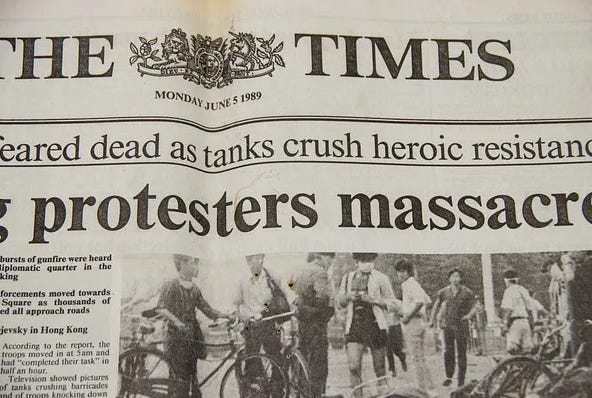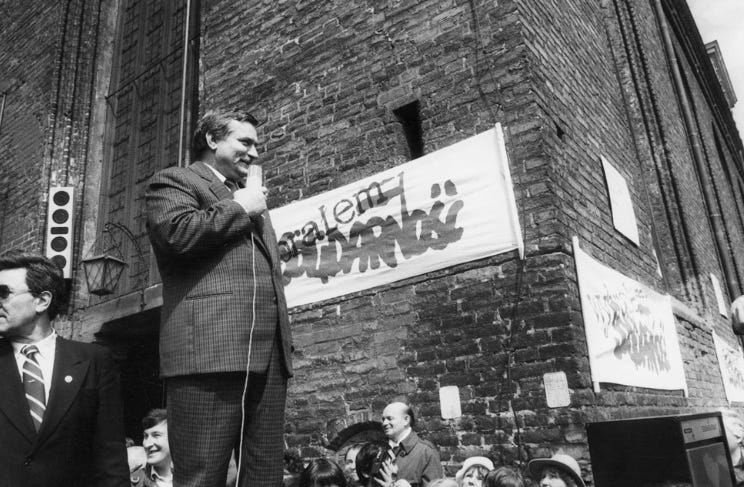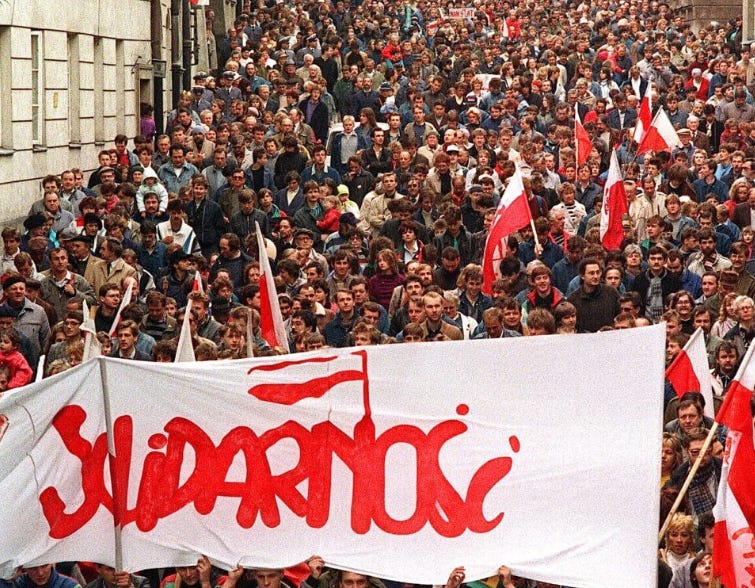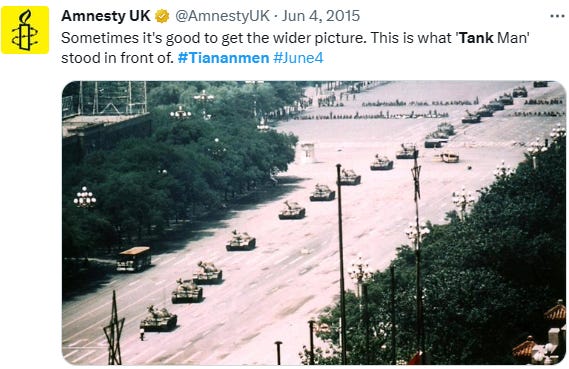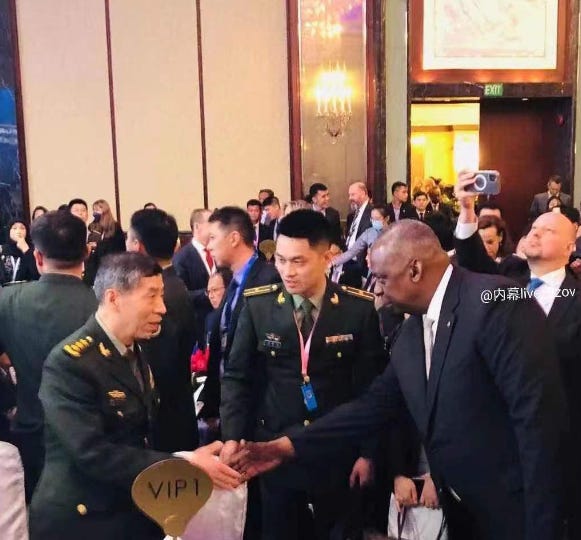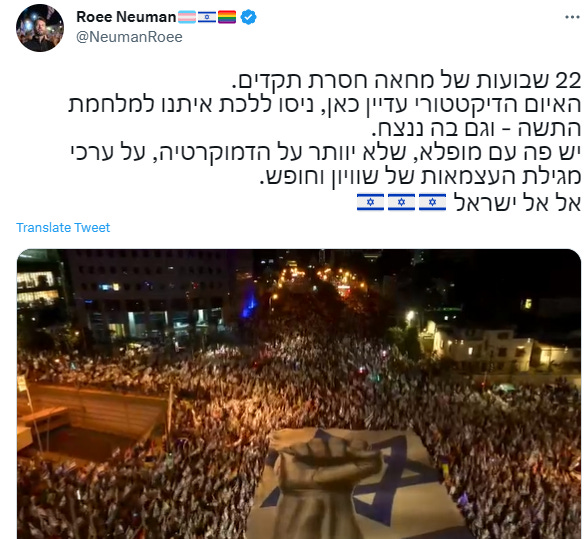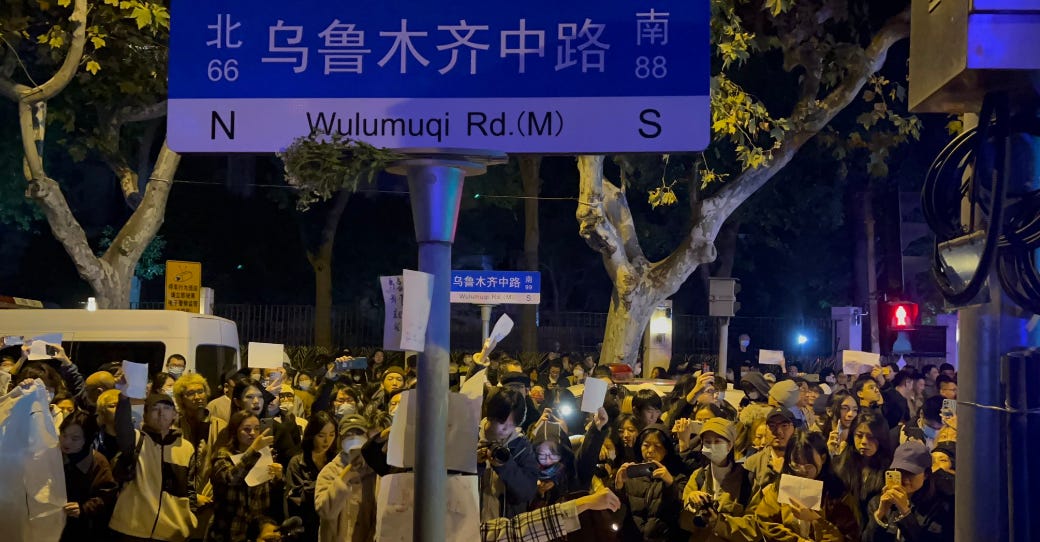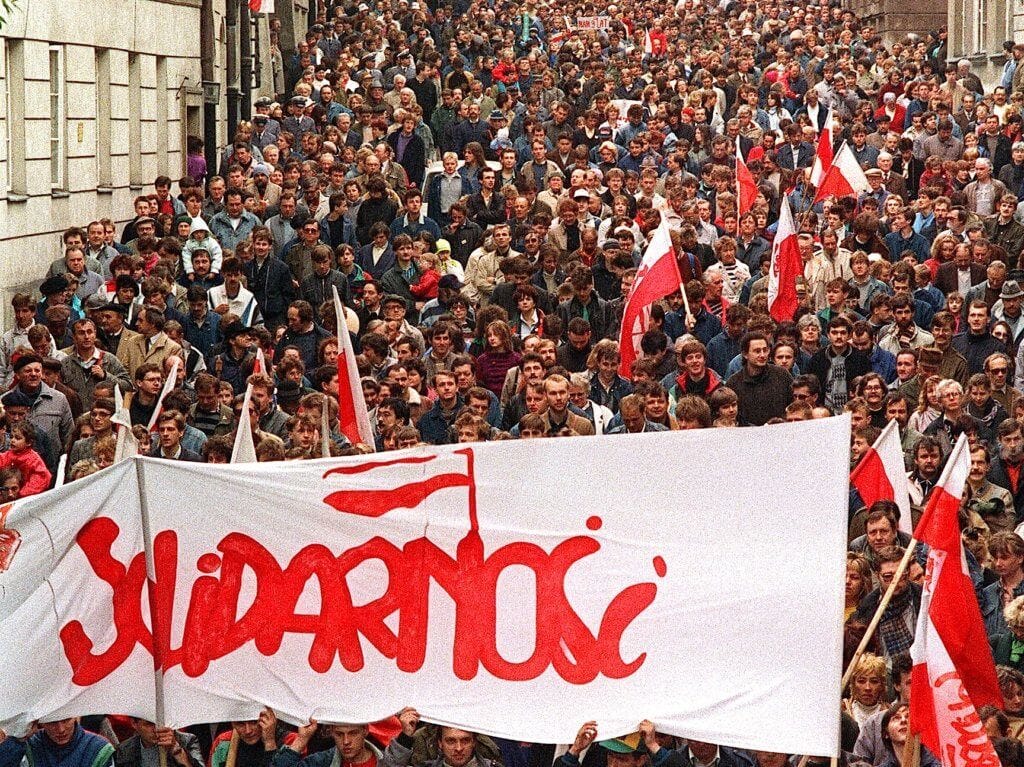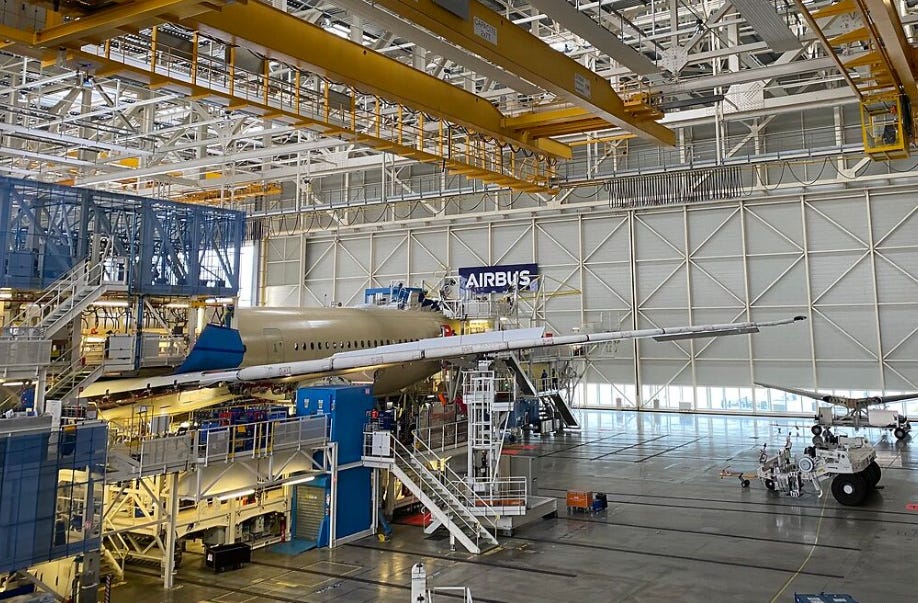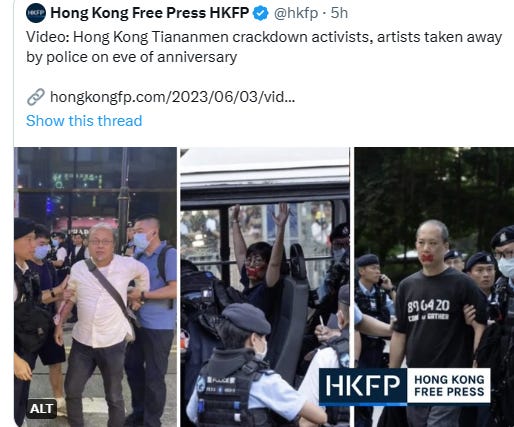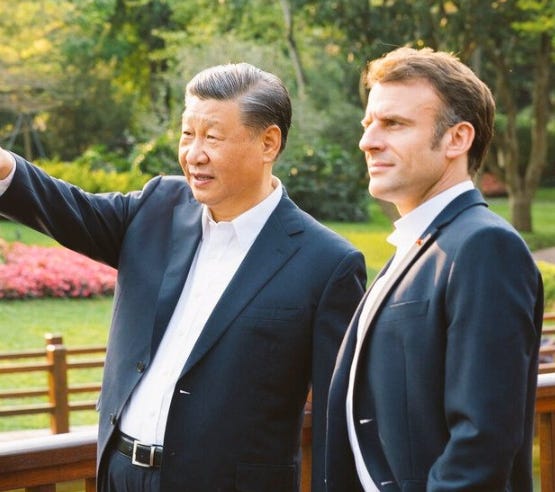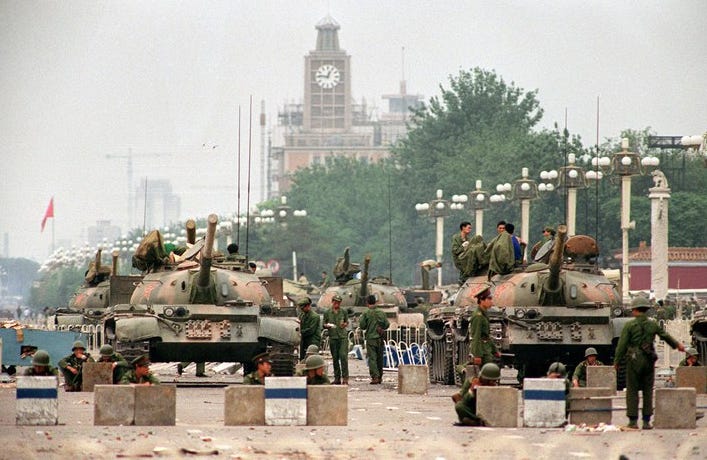34 Years After: Tiananmen June 4th, 1989 "Tank Man" and Gdansk Poland Solidarity Solidarnosc Revolution June 4th, 1989
Bejing 5.02am / Jakarta 4.02am / DC (still June 3rd, 2023) 5.02pm EDT / Warsaw (still June 3rd) 11.02pm / London (still June 3rd) 10.02pm
(1 day after Tiananmen and Gdansk Revolution. The Times, in London)
Gdańsk Stocznia (Shipyards). SOLIDARNOSC. Lech Walesa. June 4th, 1989
Legendary anonymous (never ever know who he is) Tank Man
“Tell you what: Walk into Tiananmen Square with a sign that asks about the massacre there in 1989.”
(In America time and entire Europe time) Tomorrow is the 34th anniversary of June 4. But 34 years later, and as the world and the PRC have changed so much, now to be superpowers beside the U.S.
Poland to be European Union member but to be “the most Far-Right regime in EU {alongside Hungary} and even reduplicate (judicial reform in Poland) by Israel {and tonight in Tel Aviv still protesting}, for the 22nd week in a row, a mass protest is held in Tel Aviv (June 3rd, 2023) against the Bibi (Benjamin Netanyahu) government’s push to overhaul the judicial system. Imagine EU regime, EU “far right” regime reduplicate by Israel. Some 95,000 people are demonstrating at the main rally on the coastal city’s Kaplan Street, according to a Channel 12 news estimate.
(Photo in Kaplan Street Tel Aviv 10.51pm local time, June 3rd, 2023. Roee Neuman arguably the most vocal-outspoken activist anti Netanyahu and ant Judicial Reform)
Does 1989 even matter anymore, or is it just a fading memory for fewer and fewer people? And will it eventually be forgotten by all but a few? Iconic protests against authoritarian regimes took place in both Poland and China. Their different trajectories have led to very different stories–and different silences.
One of the biggest lessons for 1989, in China, is never underestimate what the Party will do when it feels threatened. Sounds obvious I know, but it seems like a lesson each generation needs to relearn. In Poland, this gigantic museum, inaugurated in Gdansk in 2014, is at the heart of the festivities. It hosts exceptional guided tours, led by former members of the Solidarnosc movement, opponents of the communist regime during the 1970s and 1980s. The museum traces the epic of the fight against communism, led in particular by the Solidarnosc trade union. All just a few meters from the shipyards. Where Lech Walesa and his colleagues launched the protest.
Thirty years ago today, iconic protests against authoritarian regimes took place in both Poland and China. Their different trajectories have led to very different stories–and different silences. Here are some resources to track how both are being remembered in 2019.
In Poland, years of organizing by Solidarność–the shipyard workers’ union started in Gdansk in 1980–not only ushered in free-ish legislative elections on 4 June 1989, but also brought the movement a resounding victory. Poland marked the first of the “Velvet Revolutions” that brought down Soviet-aligned regimes: Hungary, East Germany, Czechoslovakia, and Romania would follow by the end of the year. The Polish experience is often held up as the easiest and most peaceful transition away from single-party communist rule (especially compared to Romania Ceausescu‘s rapid and violent fall on 25 December 1991). But Polish politics have hardly been so velvet of late. Memories are more complicated than myth-making. The ruling Law and Justice party (PiS, Prawo i Sprawiedliwość) was founded in part on Jarosław–and his twin Lech–Kaczyński’s conviction that Solidarity was far too cozy with the country’s remaining communists and that the June 4 elections were imperfect if not corrupt. the incrementalism once lauded as the key to a smoother transition is now criticized as a fundamental weakness to be purged from the Polish system.
May 28th 2023 (7 days before 34 years Tiananmen), China Eastern Airlines operated the first passenger flight of the C919, China's first domestically built large passenger jet. Flight MU9191 took off from Shanghai Hongqiao Airport and landed safely at Beijing Capital Airport after nearly two hours. As the plane taxied under the "water gate" which symbolizes the highest etiquette in civil aviation, it marked the global first commercial flight for the C919 model. This is another historic step to cementing China as superpowers. Maybe one day China has an airplane-maker with valuation same gigantic as Airbus (Germany-France / Hamburg-Toulouse) and Boeing (Seattle U.S.).
June 4th,1989 was a turning point in world history that I’m sure future generations will and still remember as such. It not only cemented CCP one party rule, but it also showed that the US and its allies were willing to put trade above human rights. It not only revamps domestic-political situation in Polish 1989 (although today Poland led by Far-Right regime). The world we live in today has been shaped by the political choices and the moral dilemmas of June 4th and its aftermath. Maybe because China currently to only competitor for U.S. as duopoly superpowers.
Chinese censors scrubbing the internet of anything that could be used to reference the Tiananmen massacre in the run-up to Sunday’s anniversary have a new target in their sights: a bridge in Beijing where a rare protest was staged last year.
As the 34th anniversary of the 1989 massacre approaches, anyone searching in Chinese for Sitong Bridge on Baidu maps will draw a blank.
On 13 October 2022 white banners with large red characters criticising the Chinese Communist party (CCP) were hung over the bridge near Beijing’s university district in advance of a major CCP congress.
According to pictures posted on social media, the road sign for Sitong Bridge has been removed. Searches on Baidu for Sitong Bridge return the message: “No related places were found.”
It is still possible to search for the bridge using the traditional Chinese characters used in Hong Kong and Taiwan, rather than the simplified characters used on the mainland. And it is still possible to find related locations, such as “Sitong Bridge East” – a nearby bus stop – on Baidu.
October’s Sitong Bridge banners called for “freedom”, “respect” and the right to be “citizens, not slaves”, as well as the removal of Xi Jinping, China’s leader, who was about to begin an unprecedented third term as the CCP’s general secretary. The man responsible for the banners, Peng Lifa, was detained by police shortly after they appeared and has not been seen since.
He has become known as Bridge Man, a reference to the Tank Man of the Tiananmen Square protests in 1989.
Peng’s stunt precipitated the White Paper protests, which called for an end to the zero-Covid policy that swept Chinese cities in late November and early December. It was a period of mass unrest the likes of which have not been seen in China since 1989.
The Tiananmen Square massacre is one of the most sensitive topics in China. Discussion of the event, in which hundreds of protesters who had been calling for political reform were killed by the People’s Liberation Army, is strictly controlled.
Over the years activists have found creative ways of referring to the event, such as “May 35th”, a covert reference to June 4th, the numbers of which are periodically banned from social media.
The character for “Si” in “Sitong Bridge” is the same as the character for four, making it especially sensitive. The anniversary has sometimes been called “internet maintenance day” because of the number of websites that go offline.
For some, it began by overhearing an offhand comment. Others found out from someone with firsthand knowledge. Some even had personal connections to those involved.
However they first learned about the June 4, 1989, massacre of students in Beijing’s Tiananmen Square, the young people were motivated to learn more, driven by a sense that the truth had been hidden from them.
Their instincts were not wrong.
China’s Communist Party has done its utmost to stymie any form of public discussion of the incident 34 years ago.
Authorities have worked tirelessly to scrub the affair from history books, online discussions and the media. Every June, police descend on the homes of dissidents, placing them under house arrest and banning them from posting on the topic or speaking to the media.
With the student protesters now well into their 50s, and children born since the massacre being raised with virtually no knowledge of the event, the passage of time is helping the Communist Party erase memories.
But China’s youth are technologically savvy and have figured out ways to get around the country’s Great Firewall of internet censorship. Many use VPNs, or virtual private networks, to mask their IP addresses, which are illegal in China, but still used widely.
Most respondents declined to give their full names, citing a fear of reprisal. Many openly expressed shock at what they discovered, some saying it had changed them forever.
Tanzhang first heard about the crackdown in 2020, when he was in junior high school, while watching a video describing cameras on Bilibili, the popular content sharing platform.
“When they mentioned [the brand] Leica, the video creator added a comment saying, ‘Leica recently filmed an ad that insulted China,’” he said, referring to a commercial in which a photographer appears to be taking photos of the People’s Liberation Army advance on students on the square, only to be confronted by authorities in his hotel.
“The comments were all cryptic, which piqued my curiosity, so I searched for more information. Later, when I revisited the video on Bilibili, I found that the comment had been deleted,” he said.
A high school student who gave his name as Liang said he learned about Twitter and Facebook in October 2021 while browsing Douyin, a Chinese TikTok-style video platform. He got a VPN account and started following a few accounts of nationalistic Chinese officials known as “wolf warriors.”
“I saw someone mentioning the Tiananmen Square massacre in the comments under a tweet by [Foreign Ministry spokesperson] Hua Chunying, so I searched for it on Google and was deeply shocked,” he said.
Several students said instructors put themselves at risk by teaching about the crackdown in class or that they managed to access censored educational materials during their studies.
“In a university elective course many years ago, the teacher secretly played a video [about the massacre] for us with the door closed, without saying a word,” said a student who gave their name as “Y.” “Nowadays it's impossible that such a thing could happen.”
Another respondent who gave his name as Guan Fu said that while in eighth grade, his modern Chinese history teacher “dedicated a whole class to explain everything about the Tiananmen Square incident.”
“That day, the beliefs that had been instilled in me since childhood collapsed,” he said. “I went back home and asked my elders about it. It turns out they all knew, but in the face of that bloody purge at the time, they chose silence.”
A respondent who identified themselves as “Student A” said a teacher had mentioned that university students in the square had been “suppressed by the government,” and that the reference was enough to make them want to dig further.
At an international school in China, teachers sealed off sections of history textbooks deemed politically sensitive before handing them back to the class for studies, said a respondent who gave their name as “Classmate S.”
“Driven by curiosity, my classmates and I cautiously tore open the seals and saw a picture in the content about China – a man blocking a tank,” he said, referring to the iconic image of an unarmed protester standing in the way of a tank on a major boulevard.
======end———
I was lured, inspired by someone writer, his post in LinkedIn months ago, “Currently after a routine daily writing newsletter in the last 10 years, my subscriber reaches 100,000. Maybe one of my subscribers is your boss.” After I get followed / subscribed by (literally) prominent AI and prominent Chief Product and Technology of mammoth global media (both: Sir, thank you so much), I try crafting more / better writing.
To get the ones who really appreciate your writing, and now prominent people appreciate my writing, priceless feeling. Prada ungated/no paywall every notes-but thank you for anyone open initiative pledge to me.
(Promoting to more engage in Substack) Seamless to listen to your favorite podcasts on Substack. You can buy a better headset to listen to a podcast here (GST DE352306207). Listeners on Apple Podcasts, Spotify, Overcast, or Pocket Casts simultaneously. podcasting can transform more of a conversation. Invite listeners to weigh in on episodes directly with you and with each other through discussion threads. At Substack, the process is to build with writers. Podcasts are an amazing feature of the Substack. I wish it had a feature to read the words we have written down without us having to do the speaking.




